This New Spin on Decades-Old Technology Can Eliminate PFAS from Wastewater
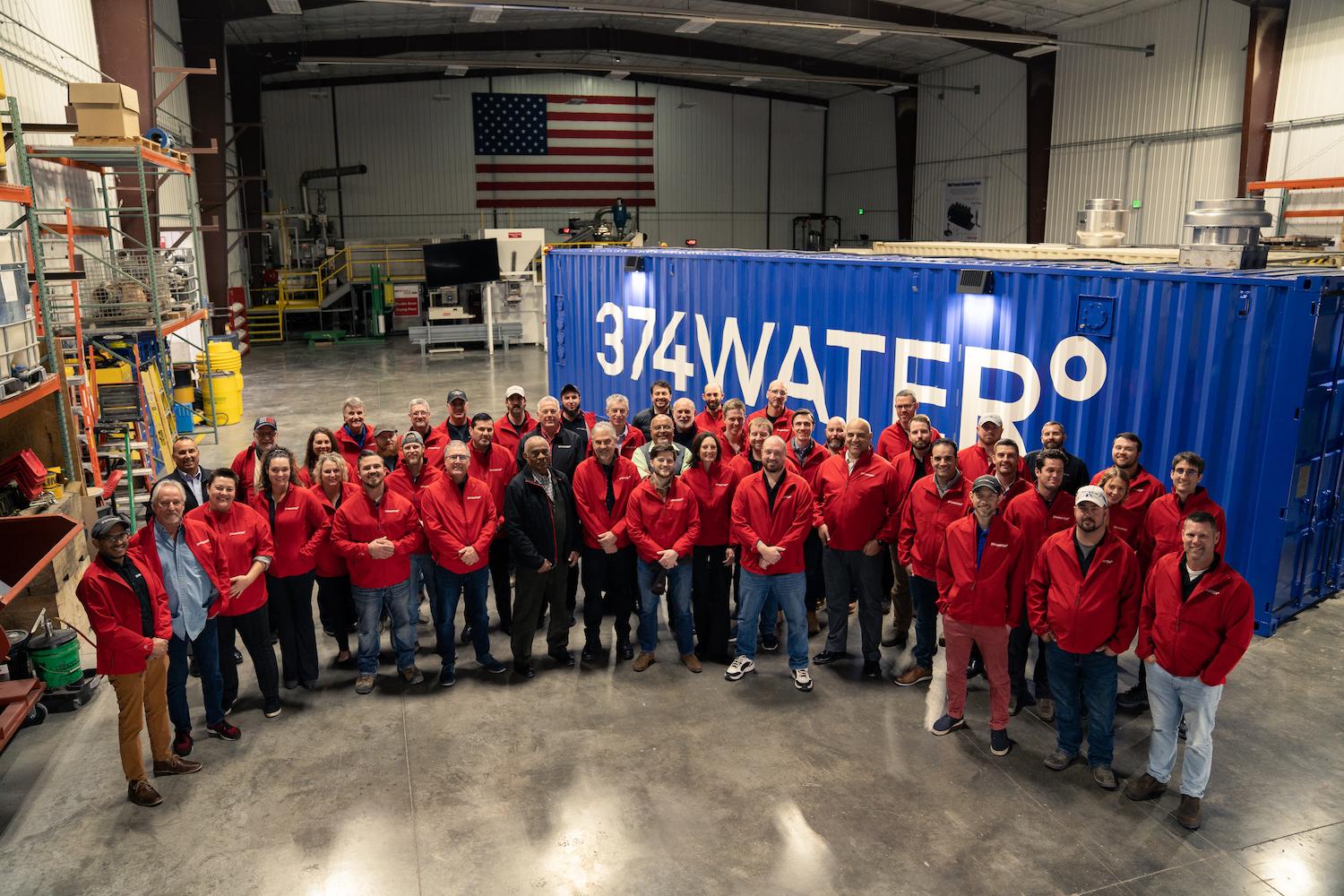
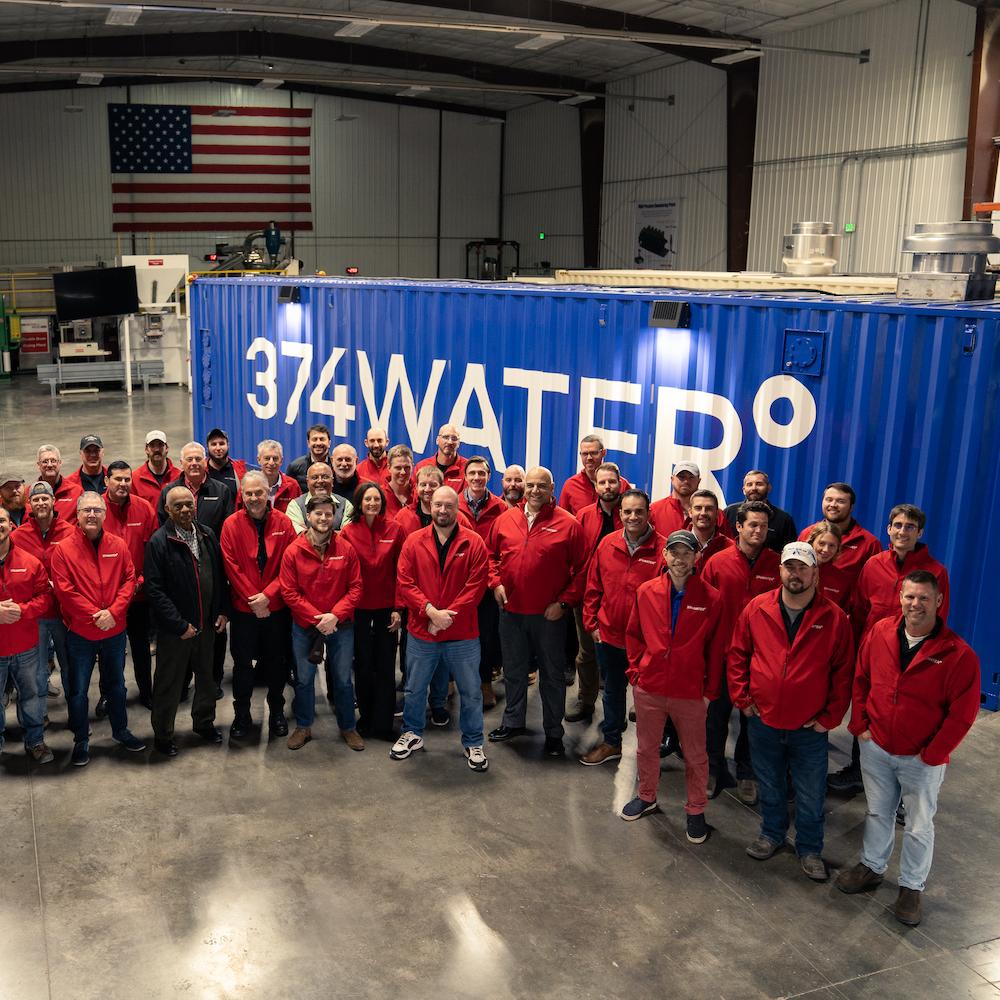
The team at North Carolina-based 374Water show off their prized invention. The container behind them may not look like much, but it can eliminate PFAS from up to 1 million gallons of wastewater per day. (Image: 374Water)
PFAS (per- and polyfluoroalkyl substances) are a group of manufactured chemicals that have been produced since the 1940s. While they have myriad useful properties and manifest in a range of products from nonstick surfaces to personal care products, concerns over their use are growing.
Current scientific research suggests exposure to PFAS may lead to a range of adverse health outcomes, including certain types of cancer, according to the U.S. Environmental Protection Agency.
PFAS are also known as “forever chemicals,” because they break down very slowly, if at all, in nature. Consequently, they continue to accumulate in greater concentrations in our environment, and by now they’ve even infiltrated our bloodstreams.
TriplePundit recently reported on new innovations aiming to mitigate the proliferation of PFAS by finding safer alternatives to them. But we need to find ways to remove existing PFAS, too.
Though this is notoriously difficult, a North Carolina-based company found a way to eliminate these chemicals, somewhat by accident, in its effort to modernize wastewater treatment. “We got lucky in that we responded to the challenge to re-invent the toilet.” Sunny Viswanathan, VP and head of global sales at 374Water, told TriplePundit.
Meeting that challenge, seeded by a grant from the Bill and Melinda Gates Foundation, focused the team on developing an optimal sanitation system which could be deployed in low-income parts of the world. In that effort, they sought ways to render waste sludges both useful and inert, leading them to consider supercritical water oxidation (SCWO) as a potential solution.
Historically, SCWO was used to destroy persistent environmental damage resulting from chemical warfare, Viswanathan told us. But his team found the technology translated well to wastewater management, while coincidentally dealing with PFAS.
What is supercritical water oxidation?
Water reaches the supercritical stage when both its temperature and pressure are increased to a point where it is no longer a liquid, nor is it a gas. Instead, as Viswanathan described it, “It goes into another ‘phase’ of water.”
Supercritical conditions for water arise at 374 degrees Celsius and a pressure of 218 atmospheres, or over 3,200 PSI (pounds-force per square inch). Once supercritical, water develops some interesting properties which are useful for processing organic waste.
“Water as a liquid can dissolve salts, but it can’t dissolve organic matter,” Viswanathan explained. He used the example of adding pepper to water, which of course won’t dissolve. Why that’s the case has to do with the shape of the water molecule and consequent polarity of water, Viswanathan explained.
A water molecule has a V-shaped structure that includes a single oxygen atom with two hydrogen atoms attached. This structure affords it a positive and negative charge at an atomic level. Because of this, ionic salts can dissolve but, with very few exceptions, most organic matter — like, in this example, pepper — will be unaffected, Viswanathan explained. But the inverse is true under supercritical conditions.
“When you go supercritical, the shape of the water molecule literally changes — which means it loses its polarity and becomes a very good solvent of organic substances and a bad solvent of salts," Viswanathan said. "Salts will come out of the solution, but now your pepper will disappear. Your poop will disappear.”
And here is the important point. Because PFAS substances are organic, “Your PFAS will disappear," he said.
In essence, under supercritical conditions, all the organic matter in wastewater — including PFAS — becomes completely dissociated. When air is added to the mix, an exothermic oxidation reaction takes place, completing the process.
“By introducing air, which has 21 percent oxygen, it will go after the carbon and make CO2 [carbon dioxide]. Once it removes carbon from the material, it becomes inorganic and will form salts and water — and energy, as it is an exothermic process," Viswanathan said.
The last point is important. An exothermic reaction is one which produces heat. 374Water’s AirSCWO system uses the heat produced by the exothermic reaction to perpetuate the process. So long as you continue to put waste sludge in, “the waste is the fuel," Viswanathan said.
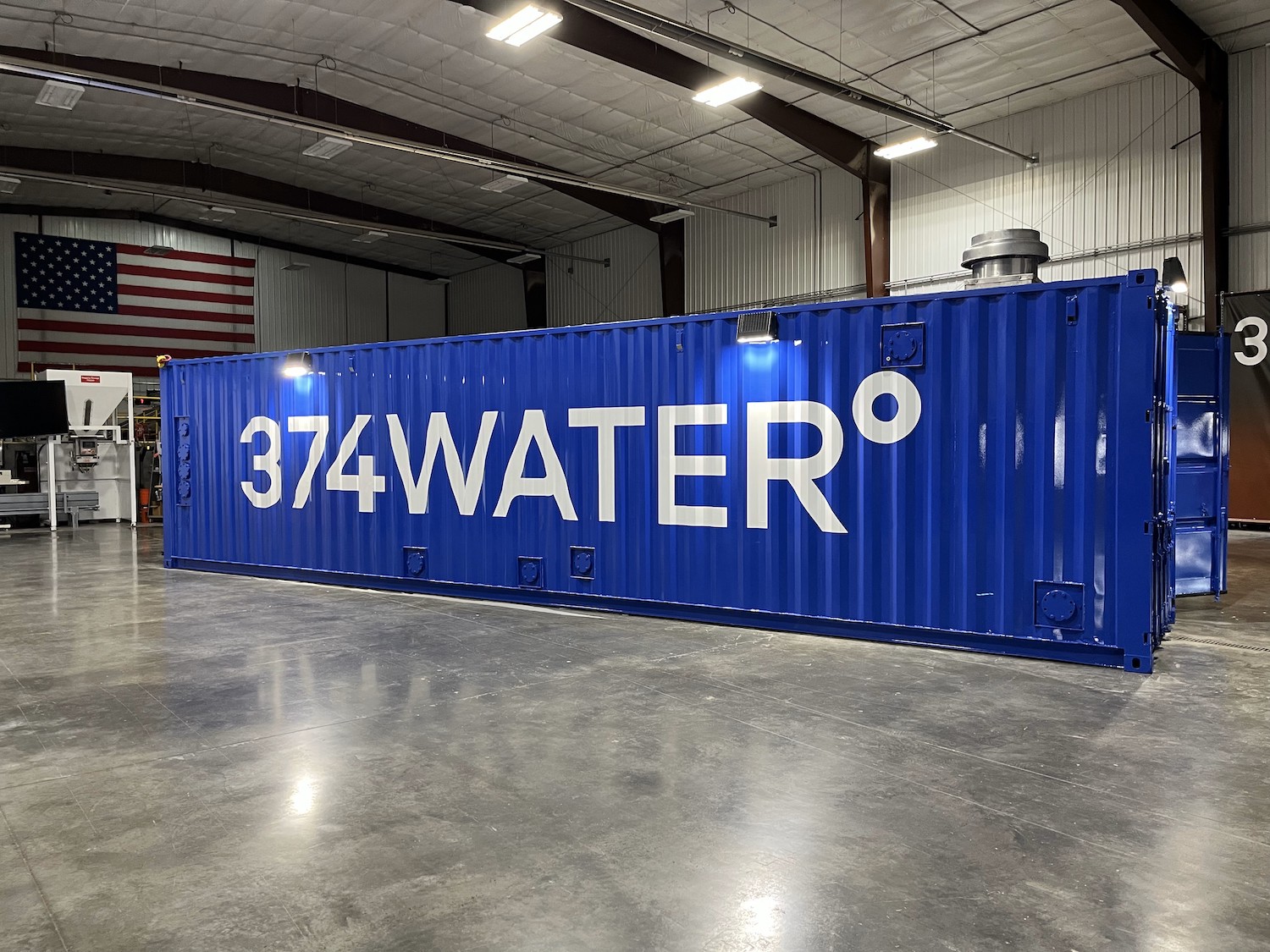
Putting the technology in the field to eliminate PFAS
With this simplified and abstract explanation of the science in mind, what does 374Water’s system look like in the field?
The company’s AirSCWO reactor units are packaged into 40-foot shipping containers (see above). The smallest reactor is a single container, while larger configurations would combine two or more. The company has plans for building-based systems, too.
Household or industrial wastewater comes into the container through a pipe at one end, and inside it, the contents of the pipe are pressurized and heated. Some external energy source is needed initially to start the system.
Wastewater sludge coming into the reactor is typically 80 percent water, and it’s the existing water content of the sludge which goes supercritical. Once that happens, all organic matter within gets dissociated and oxidized, which happens quite rapidly. “It takes four to 40 seconds to go from something that is completely toxic to something that is completely benign, clean and useful," Viswathanan said.
Indeed, it's useful in various ways. The system’s output is distilled water and useful minerals such as phosphorus which can be processed into fertilizer. Meanwhile, surplus energy from the exothermic reaction has the potential to be captured for electricity generation.
As for the PFAS, these are broken down into carbon, fluorine, hydrogen, oxygen and sulfur. As Viswathanan put it, “Just by exposing PFAS to supercritical conditions, you have actually destroyed them.”
What's next for this high-potential PFAS solution?
It’s taken 10 years for 374Water to go from concept to commercialization. The company, now traded on the NASDAQ stock exchange, will see the first of its commercial units go into operation in Orange County, California, next month.
Expansion from there will be carefully undertaken, as 374Water plans to start at a scale that is manageable. But the addressable market is substantial.
Each 40-foot reactor can process up to 1 million gallons of wastewater per day. Of the roughly 17,000 wastewater facilities treating household, commercial and some industrial wastewater in the U.S., only 9,000 of these are in the 1-million-gallon range. In theory, in combination with the larger reactors the company has planned, it would have the capacity to service all of these facilities.
That said, scalability relies to a large extent on the right incentives. The state of Maine offers one such example.
Because of PFAS, the state has banned the application of wastewater sludge on the land, an increasingly common practice on U.S. farms. That shift means water treatment plants have to spend up to $200 per ton to send their wet sludge out of state. Since 374Water’s method eliminates PFAS and produces no waste sludge, the system would provide a huge cost avoidance opportunity under these circumstances. Consequently, municipal sanitation providers could see payback on a reactor in as few as three years, Viswathanan said.
As a final point, he emphasized the long-term opportunity this way. “The technologies we are relying on now for waste treatment are nearly 100-year-old, antiquated technologies. We now have a system that is capable of not only treating the waste, but also destroying the recalcitrant waste and taking it out of the ecosystem.”
This Company Wants to Rebuild Trust in Carbon Offsets


The carbon offsets market is plagued by weak transparency, an insufficient supply of credits, and skepticism about the quality of projects intended to remove carbon from the atmosphere. Yet a contingent of companies and organizations argue that getting to net-zero emissions means confronting that trust deficit and resurrecting the carbon market’s reputation.
Among those stepping into the fray is carbon-offset and financial company Aspiration. With roots in financial technology, it's offering carbon removal products and services at a time when others might be hesitant to enter those troubled waters.
Earlier this year, an investigation into the certifier Verra alleged that over 90 percent of its rainforest carbon offsets are worthless. Further, a report from the Berkley Carbon Trading Project revealed widespread over-crediting and “dubious” carbon offsets across the market.
But just because there are problems with the market doesn’t mean it should be abandoned, Olivia Albrecht, CEO of Aspiration, told TriplePundit. She argues carbon offsets are a necessary part of the path to net-zero, alongside ambitious emission reductions.
Even the most climate-committed company, country or organization — or individual, for that matter — cannot operate at net-zero today or for the foreseeable future, Albrecht said. “There’s not enough technology available to us today to operate truly as a carbon-neutral entity. As a consequence, you're going to need carbon credits to mitigate any residual carbon exposure, carbon liability and carbon emissions from company operations.”

More than 1 billion tons worth of carbon credits have been issued over recent decades, she said. Considering the stream of greenhouse gas emissions reduction commitments around the world, achieving net-zero by 2050 will likely require over 7 billion tons of carbon removals or offsets per year.
With the growing raft of net-zero commitments, “we have an incredible supply [and] demand mismatch in the marketplace today, where there's too little supply for current and future demand,” Albrecht said.
There are also too few investment dollars allocated to natural climate solutions, she said. Some $650 billion in climate financing is distributed now, the bulk of it toward renewable energy sources.
While this is a key part of the solution, only a tiny fraction of that investment goes into natural climate solutions. In fact, the U.S. National Academy of Sciences estimates that “land-based sequestration efforts receive only about 2.5 percent of climate mitigation dollars.”
That is a missed opportunity, Albrecht said. Scientists estimate that natural climate solutions can provide 37 percent of the cost-effective carbon removal needed through 2030.
That’s why Aspiration turned its focus to the voluntary carbon credit market and “specifically focused on investments into nature-based carbon removal projects across the globe,” she said. “Natural climate solutions can be a very efficient and effective means of helping to deliver on net-zero ambitions.”
Nature-based solutions demand patience for payoff
Aspiration recognizes it entered this market for the long haul, Albrecht said. “In particular, for nature-based carbon solutions, it's not something as quick as turning on a light switch to create carbon credits. It takes multiple years to design, coordinate, organize, implement and execute high-quality, large-scale carbon projects. Trees grow at the pace that trees would like to grow. There is no accelerant to tree growth.”
Many of the projects that are nature-based are also “deeply embedded in communities where you're employing tens of thousands of farmers,” she said. “It is a huge coordination effort to engage with local communities, to attract and hire farmers from local communities, to participate in these large-scale community projects. That too takes time.”
That’s why investment should be made now to deliver the needs for the future, Albrecht explained. “Especially as we can see this incredible demand cycle in the future.”
Learning from what didn't work
“It's no secret that there's a significant amount of low-quality carbon credits in the marketplace today,” Albrecht said. “And that's too bad. We need to do more as an industry to help create global quality standards that are consistent and that can be upheld as part of the industry standard for what is and is not a carbon asset.”
Aspiration is actively involved with the Integrity Council for the Voluntary Carbon Market, which is working to propose a set of principles and global benchmarks to add much-needed credibility. Its recently issued guidelines were met with disappointment from some experts, but others commend it for advancing standards of integrity.
As for how Aspiration is approaching its investments into carbon offsets differently, Albrecht said the company has certainly taken note of the problems with the voluntary carbon offset market.
“We start with quality as our north star," she said. “We have a carbon team who have spent a decade-plus in their respective disciplines, who are biologists and scientists and experts in remote sensing and geospatial imagery.” The latter disciplines enable project oversight without the need for boots on the ground.
Aspiration’s investment partnerships include improved grazing projects with carbon offsets provider Native in the U.S. Northern Great Plains and South American Patagonia regions. The projects will increase grassland productivity and sequester carbon from the atmosphere in the soil.
The company also invests in carbon projects through Trees for the Future, a nonprofit training farmers in sustainable agroforestry practices across sub-Saharan Africa. Through this, Aspiration provides support, training and a steady income for 15,000 farmers, while planting 87 million trees in Kenya.
“We are also fastidious from a financial perspective in evaluating, understanding, and underwriting the risks and underlying projects,” Albrecht said. “Those words did not typically get used when thinking about the voluntary carbon markets before.”
Albrecht sees a shift toward traditional features of risk mitigation and management in the type of financial expertise the carbon market is attracting today. “We are starting to see more finance and legal professionals who have experience in underwriting risk coming to the table and helping to design investment solutions to help drive traditional capital,” she said. “Making this part of the carbon market will help us bring along more traditional pools of capital to invest in these assets.”
The carbon offsets industry needs to face reality in order to build trust
Reviving the carbon market’s reputation will take time, but Albrecht is confident the change is already underway.
“We in the industry can't run away from the reality that there were some lower-quality carbon assets in the market,” she said. “It starts with humility and recognition that there were some significant challenges in the market over the years. We have to proactively address that and explain what is changing on a go-forward basis and why this is going to be a more credible industry going forward.”
As that happens, carbon offsets will regain a respected place among the climate mitigation solutions needed today, she said. “If we can collectively put our heads together to make the carbon market better going forward, there's an incredible path to real environmental and societal impact to drive us forward to a net-zero global economy.”
Image credit: Spencer DeMera/Unsplash
How Consumer Goods Companies Can Turn the Tide on Plastic Waste


For the companies developing consumer products, making the needed progress can seem unattainable in an age when plastic has become a reliable and affordable go-to for packaging. It might even feel like a distraction from other priorities. So, how can consumer goods companies contribute to global goals around reducing plastic waste and pollution?
While many consumer goods companies have made ambitious targets for 2025 and beyond, success on some fronts has proven to be elusive. Progress toward the New Plastics Economy Global Commitment, signed by over 500 organizations, for example, has been a mixed bag. In 2022, the Ellen MacArthur Foundation reported that the use of recycled materials has been improving, but signatories are still using too much virgin plastic and not enough reusable plastic. The overall use of virgin plastic was reported as comparable to 2018 levels when the Commitment was first signed.
Meanwhile, regulatory pressure and consumer demand for change have only increased. More than 60 countries have enacted some form of ban or levy on plastic packaging, according to the U.N. Principles for Responsible Investment initiative. When it comes to purchasing patterns, consumers are also conscious of the packaging they buy. In a 28-country Ipsos survey, 82 percent of respondents said they prefer buying products that have as little plastic packaging as possible.
Research shows the need is urgent: If we don’t reduce waste production, we will more than exceed the boundaries of our planet by 2060. Consumer industries have a major part to play. They represent $35.2 trillion in the global economy, and reducing plastic waste is a crucial focus.
Escaping “pilot purgatory” to reduce plastic waste
Given this business case, Accenture and SAP have built expertise in the circular economy, helping clients reduce waste in product lifecycles. Drawing on this experience, extensive market research and testing, the companies have published a new report, “The Future of Packaging in the Circular Economy: 5 Actions for Long-Term Success,” that gives consumer goods companies insights and tools to build momentum for packaging circularity and achieve long-term success, escaping what the authors call “pilot purgatory.”
Research from the report shows that 66 percent of pledges to go greener on plastic have failed due to companies breaking their own commitments and targets.
Accenture and SAP reviewed corporate communications on 50 circular pilot programs between 2017 and 2023. Of those, only two programs followed up with impact measurement and consistent progress updates. “In short, the overwhelming majority of pilots have not shown progress beyond the initial announcement, with no acknowledgement of cancelled pilots or shared learnings from those projects,” the report reads.
In contrast to the culture of launching pilots that lack the infrastructure to support them to scale, the following five actions help nurture a circular system where initiatives can thrive.
Embrace authenticity and transparency
In business, it’s tough to know how far transparency should go. The important thing is to build a system of data collection and disclosure that expresses credibility to customers and builds trust among stakeholders. This starts with a comprehensive baseline of product packaging and continues by building out tools like digital twins — or virtual models that, in this case, would illustrate what’s happening in the supply chain, as well as how initiatives are progressing.
The public-private Platform for Accelerating the Circular Economy (PACE) established the Circular Economy Indicators Coalition to make disclosure of this information more feasible. By bringing standardization to circular economy metrics, the coalition aims to catalyze more robust and meaningful disclosures that push collective understanding and action forward.
Re-imagine packaging R&D
In calling for innovation, Accenture and SAP recommend first getting down to the basics. A few simple questions about the purpose of the packaging and the product help prune unnecessary elements that would get in the way of circularity.
Then comes design. Changing up materials doesn’t necessarily happen automatically, and it must be done with care. Not every material is truly scalable in an environmentally-friendly and business-sensitive way throughout a package’s lifecycle. Advanced technologies like machine learning can speed up the prototyping and testing process so that it’s easier to find solutions that achieve circular goals while also meeting business needs.
The Consumer Goods Forum, an industry group representing more than 400 companies globally, released its Golden Design Rules for packaging in 2021 to provide further guidance to the sector. The rules range from choosing the proper color to ensure plastic bottles are more easily recyclable, to reducing the use of plastic overwrap, to removing hard-to-recycle plastic resins from packaging. Though the standards are voluntary, companies within the Forum’s Coalition of Action on Plastic Waste have committed to align with them in their packaging design.
Still, packaging that’s more sustainable isn’t necessarily simpler. With “smart” elements like QR codes and digital tags that enable two-way communication, packaging can enhance engagement with customers. And if a circular design sacrifices the glam of shiny and vibrant single-use plastic, tech solutions like augmented reality experiences can expand marketing into new (cost-saving) directions.
Invest in infrastructure and communities
The beauty and complexity of circular economy goals is that they don’t end with production. A circular company has the responsibility to ensure its packaging is properly collected and repurposed at end-of-life. If this involves recycling, for example, there are various stakeholders and community features to engage and support.
The report calls out Danone as one positive example of a multinational company stepping beyond its walls to fulfill circular packaging aspirations. For example, the company helped establish the largest and most advanced PET plastic recycling facility in Indonesia and has invested significantly in recycling technology and infrastructure in North America. These initiatives have been in supplement to the company’s basic efforts at changing its packaging for the better. Today, almost three-quarters of Danone’s plastic packaging is reusable, recyclable or compostable, compared with a baseline of almost two-thirds in 2018.
Grow, reuse and explore circular business models
Here’s another roadblock to overcome. What if a company puts time, effort and money into a circular solution, but consumers don’t buy it? Or maybe the market jumps in an unexpected direction. We’ve already noted the solid and intensifying business case to pursuing circularity, but aligning properly (and securely) with these trends takes intentional efforts.
Accenture and SAP outline steps including user research, testing and learning instead of putting all your eggs in one pilot. Collaborating with other actors along the value chain also allays risks.
Further, reusable packaging offers a uniquely secure opportunity not only for resource efficiency, but also for brand loyalty. As widely reported across news outlets including Time Magazine, success in reuse requires demonstrating proper customer buy-in and low environmental impact over the course of the packaging’s lifecycle.
Collaborate to scale
It’s no accident that we find collaboration at the end of the report. Breaking down silos between companies and organizations is a big ask. Yet the authors write, “Collaboration is one of the critical and necessary components for circular packaging to gain traction.” Consumer goods companies should seek to collaborate with each other before getting to the stage of competition in the market, SAP and Accenture recommend.
Some opportunities include creating “communities of practice” that prioritize forthright communication, where companies can openly share triumphs and challenges in the march toward circularity. It’s through collaboration that companies might also find reusable packaging a more feasible option: They can work together to coordinate investments and establish the necessary relationships and infrastructure.
The bottom line
The most important element to each of these recommendations is work. That’s why Accenture and SAP called them “actions.” They aren’t targets to be made and set aside after a few months. Actually working through the outlined steps takes dedication.
The innovation and honesty required might not be comfortable, but working together can help make the path smoother. “Given the scale of the challenge, time is too short for each consumer goods company to learn the same lessons individually,” the authors write.
In the end, finding solutions to wasteful plastic packaging will make companies more compliant to regulations and appealing to customers. Consumer goods companies are uniquely positioned to lead the way.
This article series is sponsored by SAP and Accenture and produced by the TriplePundit editorial team.
Image credit: Polina Tankilevitch/Pexels
The Body Shop's Pride Month Campaign Engages Drag Performers in Support of the Equality Act


Drag performer Makayla Couture at The Body Shop.
This year's Pride Month comes as 491 pieces of anti-LGBTQ+ legislation make their way through statehouses across the U.S. and hostile rhetoric around drag performers and transgender people creates an environment that puts the community at risk.
The Body Shop, long known as an activist brand for its support of social and environmental causes, is one company that's stepping up to counter this trend and offer actionable ways for people to push for change. Its 2023 Pride Month campaign, Free to Be, celebrates drag performers and calls on customers to get involved in supporting the U.S. Equality Act — which, if passed by Congress, would extend anti-discrimination protections for the LGBTQ+ community across employment, housing, credit and more.
"The ambition is to support the drag community and the 2SLGBTQ+ community in their support of legislation, which we feel is the straightest line toward protecting them," said Hilary Lloyd, vice president of marketing and corporate responsibility for The Body Shop North America.
The Body Shop uses the designation "2SLGBTQ+" to recognize Indigenous people who identify as "two-spirit," which means they possess both feminine and masculine spiritual traits and are sometimes referred to as belonging to a "third gender." The company's inclusive support of this community extends from its retail stores and digital presence to engaging NGO partners, employees and customers to support legislative change.
Bringing Pride Month activism to life, in stores and online
The Body Shop's Pride Month campaign kicked off at North American retail stores on June 5, with local events featuring drag performers like Angel Au, Lana Ja’Rae and Makayla Couture, as well as an awareness-building campaign in partnership with the Equality Federation, an LGBTQ+ advocacy group and longtime Body Shop partner.
Signage and point-of-purchase communications featuring Angel, Lana and Makayla direct customers to learn more about the Equality Act and LGBTQ+ inclusion, and dedicated "Act Stations" tell them how to get involved. "Act, or activism, Stations in The Body Shop stores are designed and intentional environments where we conduct our advocacy work," Lloyd said. "There, customers can get educated. They can learn how to be an ally."
The Body Shop's activism stations feature key pieces of information about a given cause — in this case, it's LGBTQ+ inclusion, but the brand has also leveraged these stations for other causes like getting young people registered to vote. For the Pride Month campaign, shoppers can scan a QR code at the station to learn more about the cause and how to engage — including writing a letter to their Congressional representatives in support of the Equality Act straight from their phones.
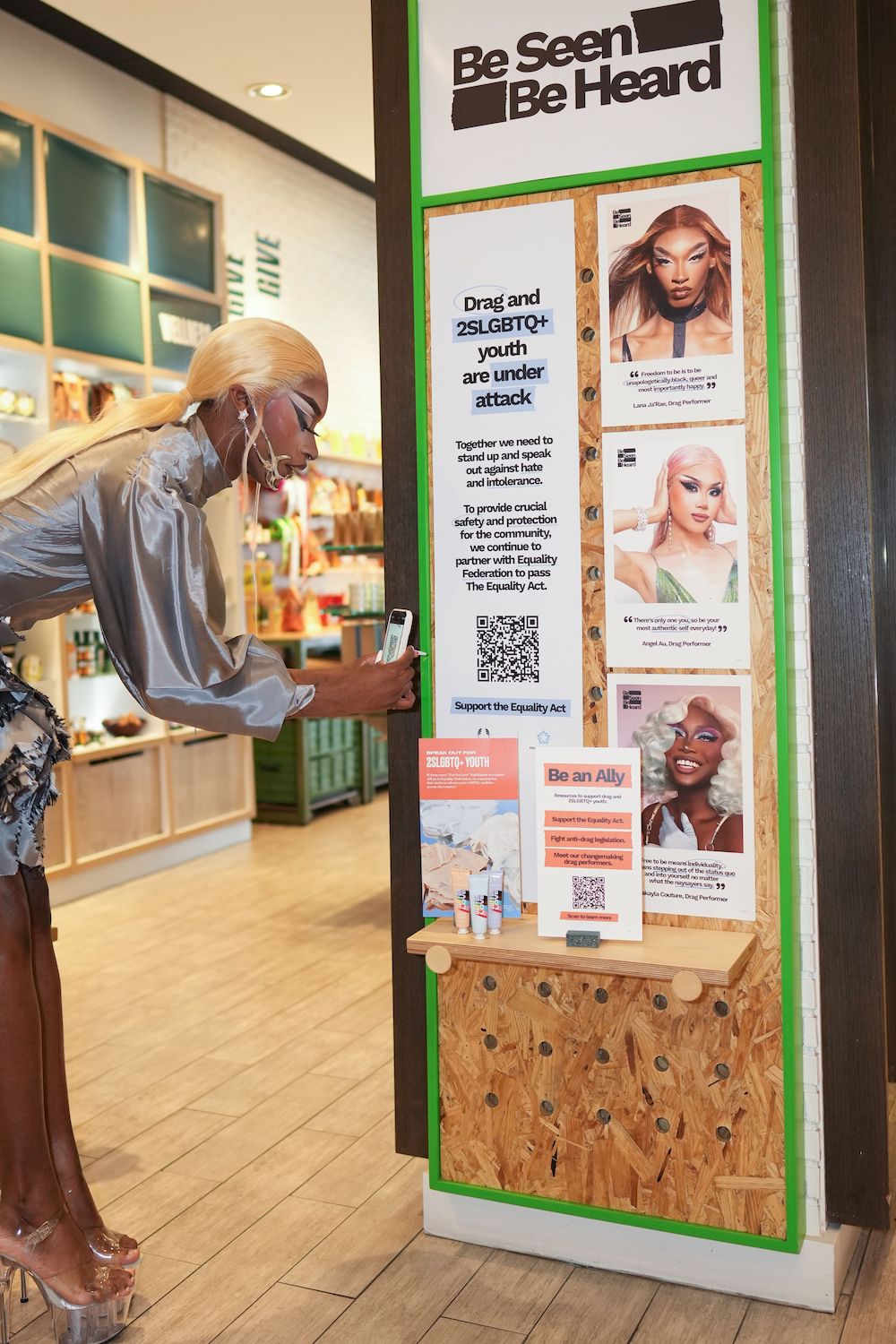
Online engagements further amplify the activism of drag performers like Angel, Lana and Makayla, tell the story of the brand's ongoing support of the Equality Act, and provide actionable steps consumers can take to push for change.
"We've created spaces across retail, social and our e-commerce environment where folks can become educated and find out how best they can support — and, for us, support looks like letter-writing and reaching out to Congress to tell them they should pass the Equality Act," Lloyd said.
Does this kind of campaigning really work?
Activists have leveraged tried and trusted tools like awareness-building, letter-writing and educational campaigning for decades. But particularly at a time when fringe voices make it seem like we're more divided than ever, do campaigns like this really work?
For Lloyd, the answer is yes. "We have good examples of this type of work working in Canada," she said. "We campaigned very similarly for the All Blood Is Equal Campaign in Canada to do away with discriminatory blood bans, particularly for the 2SLGBTQ+ community." Following campaigns from activists and companies like The Body Shop, Canada ended its policy of banning blood donations from sexually-active members of the community in 2022.
This is The Body Shop's third year advocating for the Equality Act. Over the past two weeks, more than 660 people have used the brand's tools to write letters to their representatives, with engagement building fast. "We're feeling quite motivated by what we're seeing so far in the early stages of the campaign," Lloyd said.

How can more brands get involved? Five action steps for activism
So, given the rising backlash against brands engaging with Pride Month, are Lloyd and her team nervous about all this? "Certainly, it was something we discussed," she said. "We consulted our people — our field teams, in particular, because we thought it was really important to understand how they felt about any potential backlash or risk that might exist. The overwhelming conclusion was that we need to move forward."
But rather than boycotts, The Body Shop's authentic approach created something else altogether. "The response and reaction to our work in this space has been mostly positive, and I think it's because we're expected to be here and we should be here," Lloyd said. "It's the right thing to do, particularly because of our position on social progress."
But yours doesn't have to be an activist business to get involved, and Lloyd shared her top tips for how organizations of all kinds can push change forward.
Partner up. "Get the right partners on board, get yourselves educated, and ensure that you are listening to folks who can really support you through this type of advocacy work," Lloyd recommends.
Check your own house. "Look inward at your own business and make sure the advocacy that you're planning is reflected inside your business equally to what it is you have planned to do outside of your business," Lloyd said. For The Body Shop, this means ongoing and reciprocal relationships between the company and its LGBTQ+ employees.
"We have a group called TBS Together, and it's an internal network of 2SLGBTQ+ employees who help The Body Shop to be inclusive through their collective feedback," Lloyd said. "We introduced, for example, a transitioning at work policy in 2021, which is specifically designed to support transitioning employees to ensure they're treated with dignity and respect." The company also leveraged employee feedback to create a Work in Pride charter to formalize its support of inclusion in the workplace.
Start a conversation. "Talk to your people," Lloyd said simply. "If this is an area that's of passion, that is important for your people, listen to them, take their advice and make sure they feel supported."
Get involved in your own way. "There are a lot of ways to do this type of work. And at this point in U.S. discourse, authentic advocacy of any type is welcome — whether it's uplifting others who occupy this space, supporting organizations who protect others in this space, or actually planting a flag, so to speak, and putting your corporate voice behind it," Lloyd said. "All meaningful work here is good work at the moment."
Keep it going. Far too many campaigns pop up and fizzle out after Pride Month, Black History Month, International Women's Day or other observances come to a close. But to create meaningful change on these issues your teams and customers care about, you have to keep it going. "Until we see meaningful change, we will continue to advocate in this space," Lloyd said. "As we continually see damaging and harmful legislation introduced, again we will use our platforms as an opportunity, and we'll platform others and allow them to remind the public at large of the importance of the Equality Act. We do that on a continual basis, and we always will — until we see meaningful change."
Images courtesy of The Body Shop
The Public is Behind U.S. Corporations That Stand Up for Abortion Rights, Survey Finds
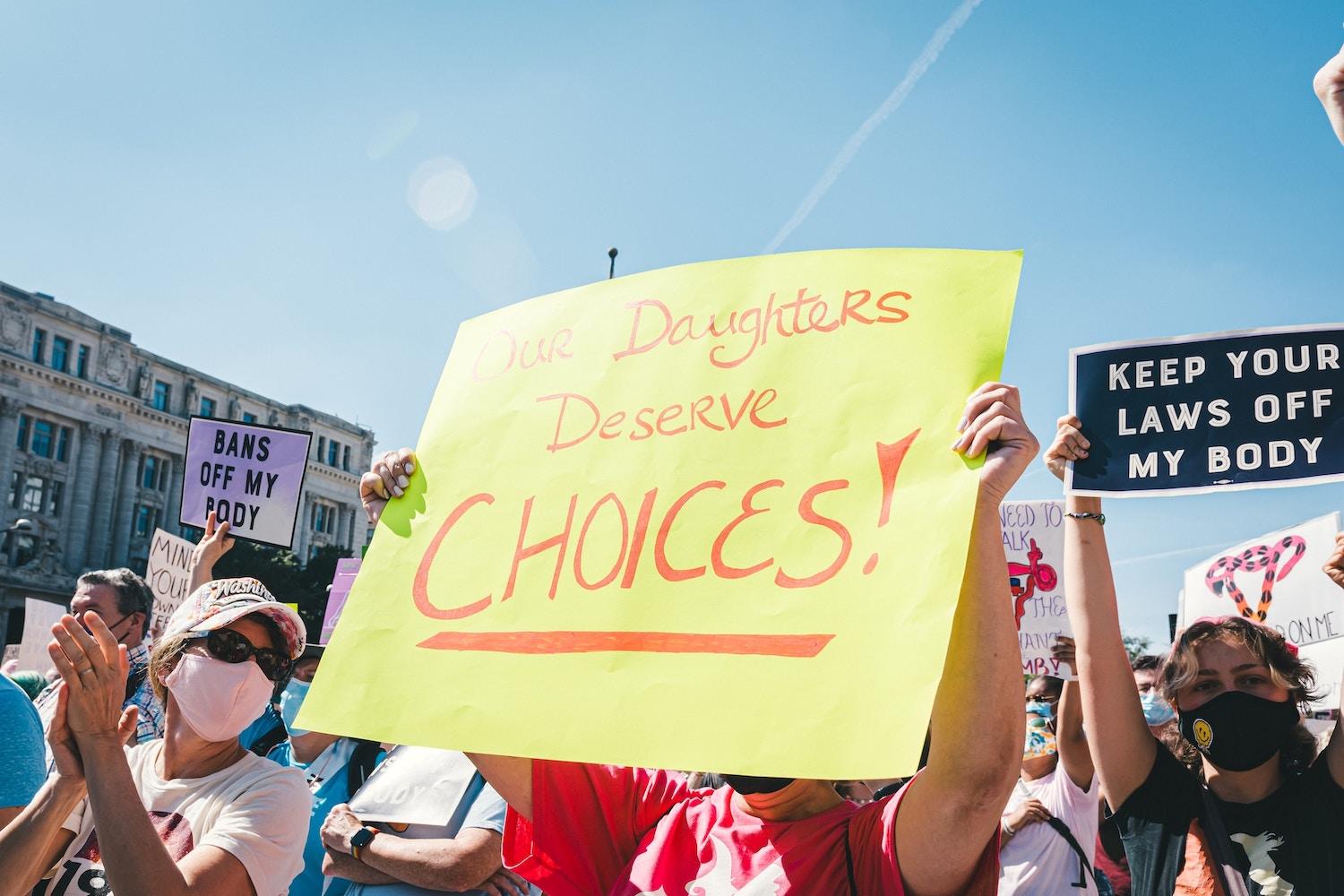
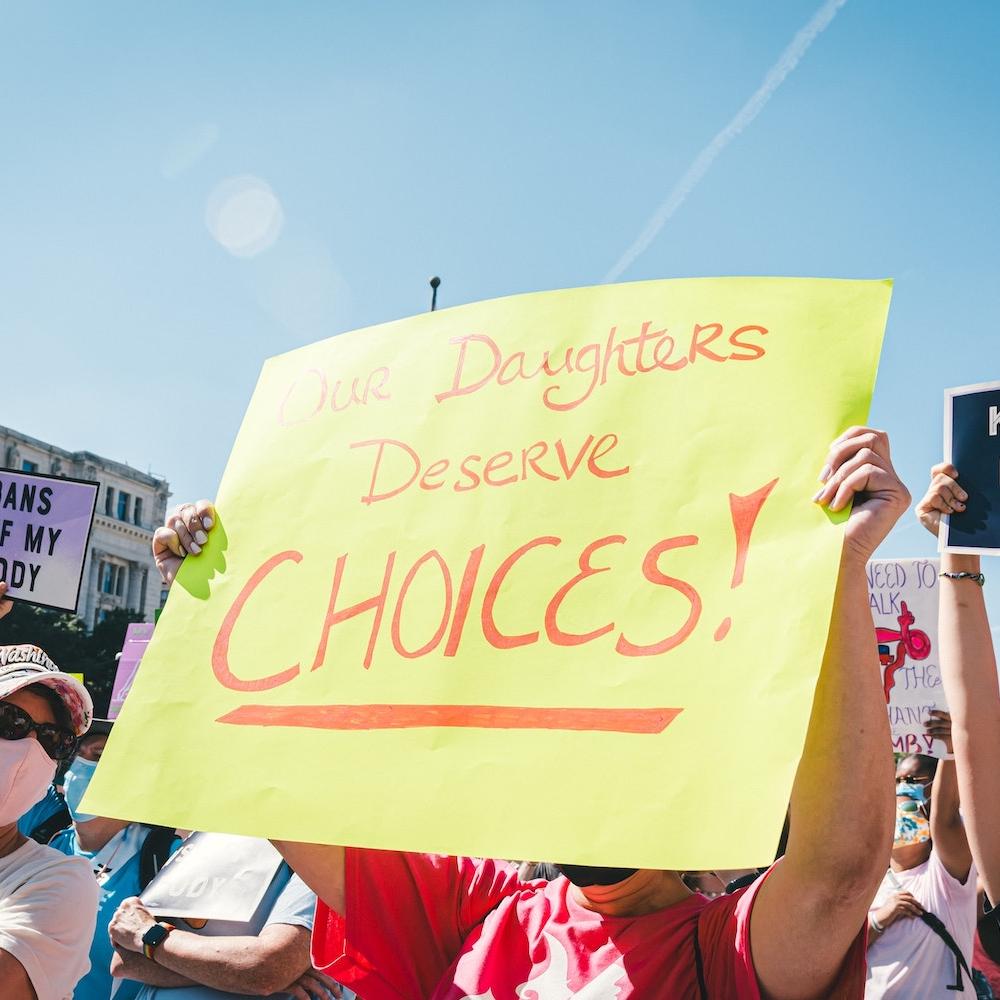
A cacophony of anti-abortion rhetoric has drowned out the voice of public opinion, but the tide is beginning to turn. A growing body of polling indicates that the average American consumer is solidly in favor of abortion rights. That provides business leaders with a supportive environment in which to advocate for the ability of women, girls and other pregnancy-capable people to manage their pregnancies under the guidance of medical science, not religion-based extremism.
Abortion rights are under attack in all 50 states, not just some
Suffolk University conducted the latest public survey on abortion issues earlier this month as part of an ongoing partnership with the USA Today news organization.
The poll was open between June 5 and June 9, almost one year to the week since the U.S. Supreme Court rendered its decision on the Dobbs vs. Jackson Women’s Health case on June 24, 2022. That decision was rendered by the court’s supermajority of six conservative, Republican-appointed justices, who ignored evidence to overturn the federal abortion protections of the 1973 Roe v. Wade case.
The Dobbs decision empowered legislators in Republican-dominated states to restrict abortion access. Within six months following the decision, 24 state legislatures followed through and imposed new limits, or had new limits under consideration.
Those restrictions necessarily entail a significant new regime of government-sanctioned tracking and intrusion, even to the extent of restricting travel to other states where abortion rights are still protected. That spreads the impact to pregnancy-capable residents of all 50 states, who now need to assess their risks while traveling in an anti-abortion state.
Also contributing to the 50-state impact is a decision rendered by another conservative Republican appointee, U.S. District Court Judge Matthew Kacsmaryk of the Northern District of Texas. On April 7 of this year, Kacsmaryk overturned 23 years of rulings by the U.S. Food and Drug Administration on the safety of mifepristone, a drug commonly used to induce an abortion early in a pregnancy. The decision rippled out from abortion-banning states to impact pharmacy customers in other states as well.
Public polling on anti-abortion activism: Stop the insanity
The public has also been exposed to a growing number of horrific stories, as more women come forward with their personal experiences of being denied safe, appropriate medical care to terminate a pregnancy.
In this context, the results of the new USA Today/Suffolk University poll indicate that the public is firmly on the side of human rights and civil rights, along with access to medical care.
The respondents came out against the Dobbs decision by 58 percent in favor compared to 30 percent opposed, a margin of almost 2 to 1. That finding is consistent with other polling on Dobbs, including a Gallup survey taken in May of this year.
The USA Today/Suffolk survey also measured how opinions on abortion changed following the Dobbs ruling. The response is significant for business leaders seeking common ground, because it indicates a positive shift toward abortion rights rather than a continuation of existing opinion.
“By almost 4-1 [23 percent to 6 percent], those whose views on abortion have changed in the past year said they have become more supportive of legal abortion, not less supportive,” the USA Today reporting team observed in an article published on June 18. “That includes more women than men, more Democrats than Republicans, and more younger voters than seniors.”
“The shift was pronounced among Black respondents,” they added. “Almost a third, 32 percent, said they had become more supportive of abortion access in the past year.”
A strong message on abortion for U.S. business leaders
The political differences on display in the poll remain a concern for businesses that are trying to navigate consumer relations in a hyper-partisan environment. However, the poll also detected a strong current of non-partisan support for abortion rights, especially among women. In the poll, women who identify as politically Independent slightly outperformed the 4-1 average, with 28 percent saying they became more supportive of abortion rights after Dobbs, compared to 5 percent who did not.
In another indication that the national mood is more non-partisan and temperate than anti-abortion activists and their allies on the federal bench may presume, the poll displayed a resounding thumbs-down for any federal law banning abortion nationwide. Eighty percent of respondents oppose a federal ban, compared to only 14 percent who'd support one. Among those opposed were 65 percent of Republicans and 83 percent of Independents.
Lessons for U.S. businesses
Despite the strong showing of non-partisan support for abortion rights, public opinion can’t undo what has already been done. Until Congress acts to fill the gaping hole carved out by the Dobbs decision, businesses must cope with the fallout from new state anti-abortion legislation for years to come.
That fallout includes the impact on workforce recruitment, especially in high-demand fields. Last August, for example, CNBC took stock of the ripple effect on the workforce in anti-abortion states. “Roughly 1 in 3 job-seekers say they won’t apply to a job in a state with an abortion ban, according to an August ResumeBuilder survey of 1,000 people,” CNBC reported. “And 1 in 4 job-seekers currently living in a restrictive state is applying to jobs only where abortion is legal.”
Anti-abortion legislation is also impacting college choice, indicating that businesses in anti-abortion states may face a brain drain that lasts for years.
The overall impact on health care in anti-abortion states is sending up red flags as well. In addition to doctors who are retiring or relocating on account of anti-abortion laws, a recent medical school survey indicates it will be difficult for anti-abortion states to recruit new doctors, leading to gaps in care that affect all residents, whether they're pregnancy-capable or not.
If business leaders are hoping the whole issue will fade away, that is highly unlikely. Women who have been impacted by anti-abortion laws have begun taking their horror stories to court, virtually guaranteeing that media attention will increase as the 2024 election cycle draws closer.
Further raising the media profile is the Joe Biden administration, which is hosting a series of events in recognition of the one-year anniversary of the Dobbs decision on June 24. Democrats in Congress are supporting the White House by pressing for new legislation to restore abortion rights nationwide.
Public opinion is firmly on the side of abortion rights, regardless of partisan politics. Business leaders should throw out the “deeply held beliefs” script and prepare to have a clear, strong, fact-based, science-oriented answer ready when customers, clients and employees ask for their stand on abortion.
Image credit: Gayatri Malhotra/Unsplash
Shipping Heavy Equipment Is No Easy Task: Can It Be More Sustainable?
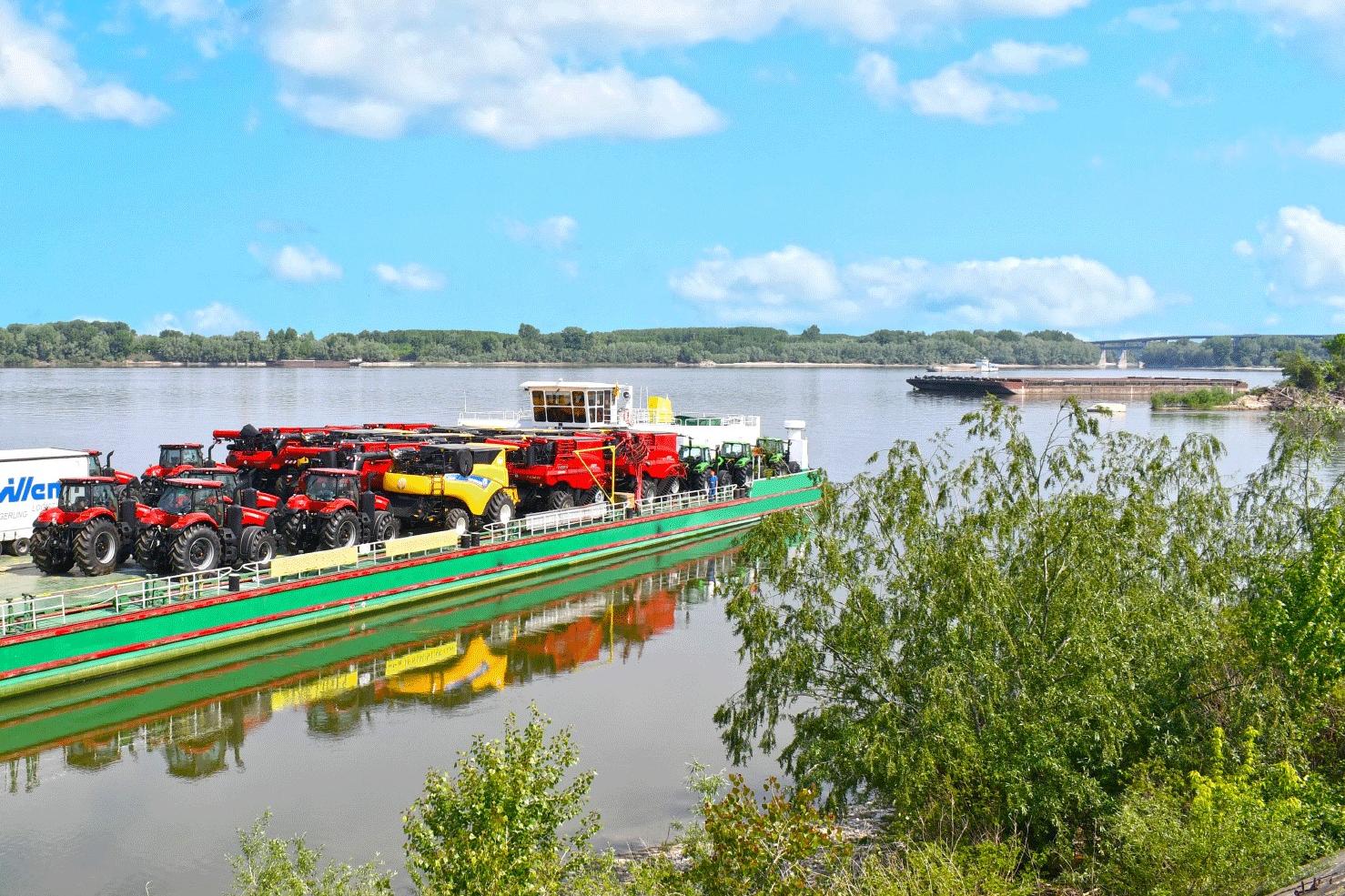
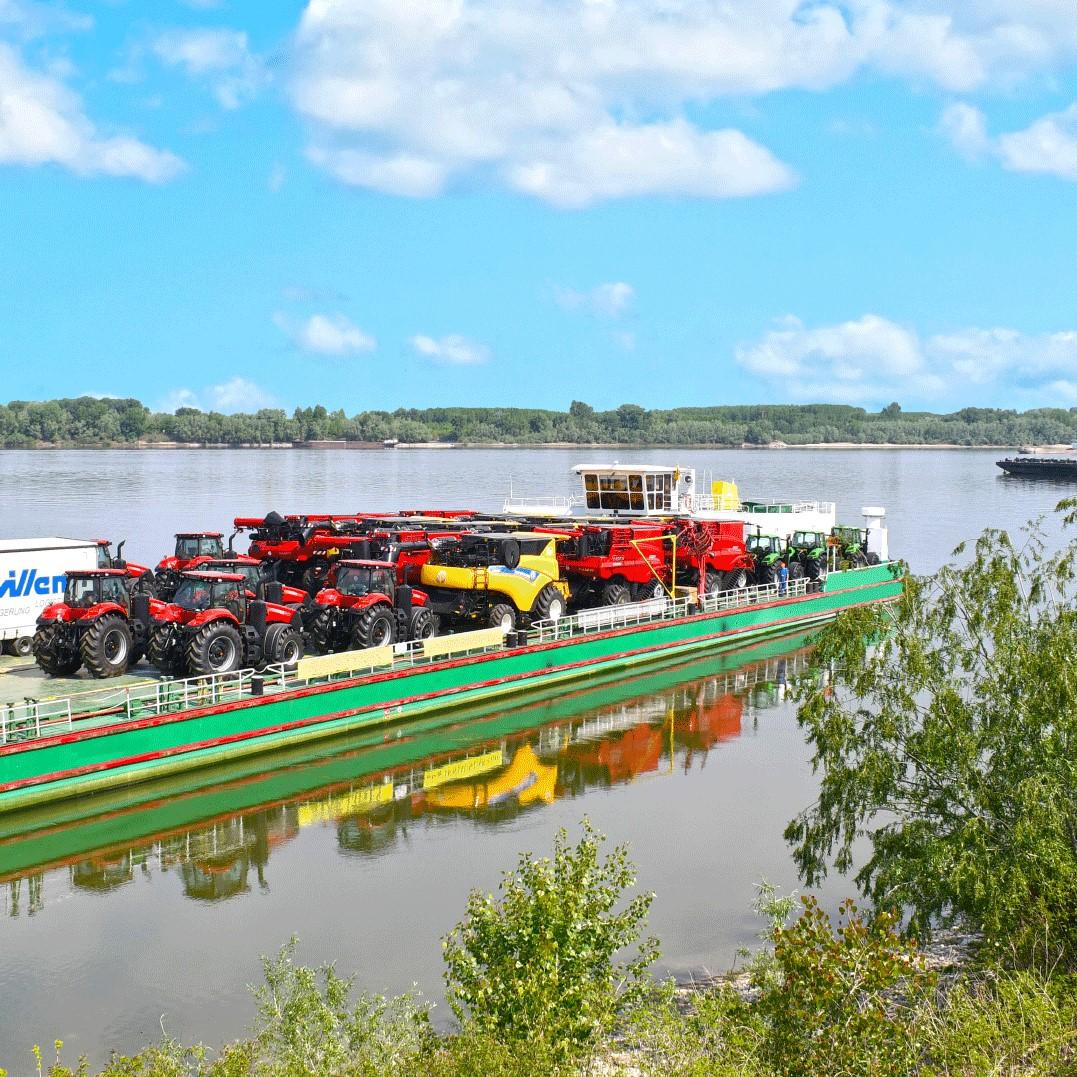
For many people, when they think about shipping, what might come to mind is taking a package to the post office or receiving something from Amazon.
For CNH Industrial, a manufacturer of agricultural and construction equipment, shipping might mean moving a 24-ton tractor out of wintry Fargo, North Dakota, or a bulky combine harvester from Nebraska to the easternmost parts of Europe.
The sheer size of these pieces of equipment, long lead times, and often months-long journeys from factory to final customer means that pretty much every shipment is meticulously and uniquely planned. A single shipment might involve transportation across road, rail, ocean and river as the machine progresses toward the end customer.
Due to physical constraints, the choice of options is often limited when moving a heavy object like a combine harvester to its final destination. Logistics planners must negotiate seasonality requirements and assess the routes and modes of transport that are even capable of handling such outsize equipment, while still meeting customer requirements and expectations.
As tough as this job can be, CNH Industrial strives to be mindful about doing things in as environmentally beneficial a way as possible.
Alberto Mela, transport logistics director at CNH Industrial, explained the approach the company takes in moving these massive pieces of equipment, and the challenges and opportunities to mitigate emissions as his team goes about their daily business.
Sustainability in logistics: Making sustainable choices on a journey from Nebraska to the Balkans
“We’re always focused on alternative ways of managing transport, because as a company we are focused on reducing emissions,” Mela says. “We always have, as our target, ways to develop initiatives that can reduce emissions. It also has to be operationally beneficial.”
Generally speaking, achieving environmental improvements means keeping shipments of these huge pieces of equipment off the roads. To that end, Mela says, “we don’t see the road as the future,” citing pollution, traffic volumes and increasing regulatory constraints in Europe as examples of the problems encountered with this transportation mode.
That doesn’t mean the road can always be avoided, but the company can still try to limit it wherever possible.
Take shipments of combine harvesters that the company has to plan. These originate in Grand Island, Nebraska, and on one of their supply routes, they have to make their way to Ruse in Bulgaria.
Total end-to-end shipping from Nebraska to Bulgaria can take anywhere from two to three months to execute. However you break down the journey, logistics managers like those at CNH Industrial are stuck with only one transportation-mode option for certain legs of the journey. Crossing the Atlantic, for example, has to be by ocean, and some of the journey in Western Europe has to be over the road.
However, with optimal planning, other parts of the journey can be arranged to dovetail environmentally advantageous objectives with desired operational benefits. For example, the U.S. leg from Nebraska to the Atlantic Ocean port in Baltimore can sometimes be shifted to rail.
This is by no means the easiest option. Shipping by road is both faster and more flexible than rail. It takes five days to move product to Baltimore by road and 15 days by rail, Lauren Ehleiter, CNH Industrial’s North America outbound manager says. The company would also have to ship multiple combines together on this leg of the journey to even make rail viable.
But if CNH Industrial analyzes when customers need the equipment in Europe, it can spot opportunities to consolidate different orders together to make this leg of the journey by train. And there is a benefit in switching even part of this leg to rail.
For example, the company can ship via road to Chicago and by rail the rest of the way, which takes 10 days. Since that five-day difference might be critical in allowing the necessary consolidation of shipments to Baltimore, the road/rail combination can still offer a sweet spot to achieve efficiencies.
Once they leave the port of Baltimore, the combines are shipped by sea to Zeebrugge in Belgium. Ocean is the only mode of transportation available for this leg of course, but still, with limited sailings, the timing of arrival in Baltimore from Nebraska is critical to meet vessel departures. It’s all part of the planning!
From Zeebrugge to Duggendorf in Germany, European rail constraints force shipments back onto the road. But in Duggendorf, instead of continuing by road, the combines can be shipped the rest of the way to Bulgaria by river barge.
Going by barge from Duggendorf again allows CNH Industrial to plan for the environmentally favorable option while enjoying an operational benefit. In this case, the operational benefit is being able to dock in Ruse, Bulgaria, on the south side of the Danube River. Happily, that means avoiding an otherwise problematic bridge crossing that would be necessary if coming from the north side of the river by road.
When putting these supply chains together, “the key is planning,” Mela explains, adding that while you cannot always optimize for the most sustainable solution, his team at CNH Industrial always looks for ways to do it when they can.
Making sustainable shifts on shipping within Europe
Another example of CNH Industrial trying to leave the road behind is the intra-European transportation of tractors manufactured in Turkey.
Historically, these would all ship by ocean vessel to the port of Livorno on the west coast of Tuscany, and move by road to the company’s distribution facility in the northern Italian city of Parma. The tractors were then distributed from Parma by road to their end customers throughout Europe.
But now, “we are looking to change this paradigm,” Mela says. Again, this involves moving freight more often by sea. Already, the company is reaching markets in Spain and Portugal by shipping to seaports in Barcelona and Valencia.
Building further on the concept, as of May this year, CNH Industrial has also swapped road freight for sea freight to reach customers in France. By shipping to the port of Sète in southern France, the company can bypass the Parma distribution center altogether and avoid road transportation all the way from Italy to the French border.
Next, CNH Industrial hopes to ship directly by ocean to the U.K. market, too.
It’s not easy, but it can work
While out of sight for many people, logistics is a huge, multi-trillion-dollar industry, with a consequently huge carbon footprint. While it’s not an easy fix to make logistics more environmentally sustainable, CNH Industrial, by way of making changes to supply chains as described here, illustrates there are always opportunities to do better.
“It’s complex,” says Mela, talking about new systems being put in place for transporting tractors manufactured in Turkey. “When renegotiating these flows, we have to weigh environmental considerations against a combination of drivers such as quality, time and cost.”
The main shipping carriers are also doing their part, said Selma Maia, transport logistics vice president at CNH Industrial. “We are starting to see that our shipping partners are making large investments in committing to zero net carbon emissions,” she said.” The main ocean shipping lines are looking at their flows, purchasing new vessels that run on greener fuels and seriously committing to rolling out their reduced carbon freight initiatives in the coming years.”
But when the overarching objective is to mitigate emissions, even when options are limited moving such large pieces of equipment, it’s worth the effort.
This article series is sponsored by CNH Industrial and produced by the TriplePundit editorial team.
Image courtesy of CNH Industrial
Why Are Corporate Climate Disclosures Important, and How Can Investors Put the Pressure On?


An orange hue tints New York City on June 7 as smoke from more than 100 wildfires across Quebec, Canada, filters south. Wildfire seasons are starting earlier, lasting longer and causing more damage due to climate change, scientists say. (Image: Metropolitan Transportation Authority/Flickr)
The annual Non-Disclosure Campaign engages investors to directly request climate disclosures from top companies responsible for high levels of greenhouse gas emissions.
Organized by the nonprofit CDP (formerly the Carbon Disclosure Project), this year's campaign includes nearly 300 global financial institutions with almost $29 trillion in assets under management. They're calling for disclosure from over 1,600 high-impact companies — including Saudi Aramco, ExxonMobil, Tesla, Chevron, Caterpillar and Volvo. Together, these companies emit nearly the same amount of greenhouse gases as the United Kingdom, European Union and Canada combined, according to CDP. And they've all failed to respond to the nonprofit’s climate disclosure requests.
So, why are climate disclosures important, and how can investors and other stakeholders put the pressure on more companies to disclose? We sat down with Sebastian O’Connor, an associate director at CDP whose team has conducted the Non-Disclosure Campaign since 2017, to learn more.
Why are environmental and climate disclosures important?
“The theory of change behind CDP is quite simply what gets measured gets managed,” O’Connor said. “The end goal of all of our work on climate change is to get emissions down to zero. To get to that point, you need a target that is feasible but ambitious. And to get a target, you need to know where you start.”
While climate disclosures are the most common kind of disclosure reported to CDP, many companies also disclose their water and forest impacts, O’Connor said. “It is more than climate. The whole aspect of nature should be disclosed against — climate and nature are interlinked.”
Corporate climate disclosures encompass business activities that produce emissions, including in the company value chain. Because the world still lacks a global standardized reporting framework, CDP is one of the recognized industry leaders in evaluating climate and nature impacts.
“CDP is the best avenue for standardized, comparable disclosures that can be assessed and graded to see how well a company is doing,” O’Connor said. “We need to know how corporations are impacting the environment in order to create a sustainable economy.”
Why do companies fail to disclose?
Corporations give various reasons for refusing to disclose their climate, water or other nature-related impacts. Some companies cite the time and resources it takes to complete a CDP questionnaire, while others choose to publish their own sustainability reports instead of going through third parties. But self-published reports can be bias, O'Connor said.
“The devil is truly in the details, as companies can decide what to omit and what to publish,” he told us. “Will companies put out anything that goes against the narrative of them always making progress?”
CDP also allows the public to compare companies against others in their peer group in a standardized way that is assessed by an independent third party.
Putting on the pressure
O’Connor thinks chronic non-disclosing companies might not be getting enough pressure from regulators and their investors, but this is changing. “There is clear pressure from regulatory regimes in every part of the world,” he said. “Regulators are paying attention because climate and nature impact the financial security of the world economy. This year, our Non-Disclosure Campaign got 288 signatories to sign on, a quadruple increase from 2017.”
Supporters of this year’s campaign included investors, asset managers, asset owners, insurance companies and other financial institutions. The nonprofit typically sees success because of the direct, simple nature of the requests, O’Connor said.
“CDP acts as an effective bridge between financial institutions and the corporate world,” he said. “We facilitate meetings that often revolve around companies giving their reasons for not disclosing. Then, investors are able to show the benefits to disclosing. When this happens, we have a high rate of previously non-disclosing companies disclosing the following year.”
As governments around the world move toward standardized reporting frameworks, CDP is working to ensure that the regulations are rigorous and ambitious, O’Connor said.
“CDP came into play 20 years ago because regulation did not exist,” he explained. “We formed the foundation of the ESG [environmental, social and governance] universe that we see today." While regulated disclosures are a welcome change, "we can also influence these regulations to make sure they do not just go to the lowest common denominator," he said.
“It is about more than just disclosure. We want to help guide companies through every step that leads them to being truly sustainable.”